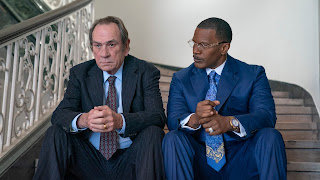A Question of Ratings
One of the most fascinating discussions from Faith in Film on Wednesday night was when we discussed trends in motion pictures. I have felt, for the last five or six years, like the standards for entertainment in this country have really loosened to a detrimental level. No where is that more evident than in the application of ratings from the Motion Picture Association of America.
Consider that the PG-13 rating was first introduced in the 1980s. The first test film, and really the impetus for the change, was "Indiana Jones and the Temple of Doom." Due to the darker themes in the film, Steven Spielberg, traditionally one of the more family-friendly filmmakers, felt the film wasn't appropriate for younger views. He didn't think it deserved the more restrictive R rating, but he felt parents needed to be cautious about the age of children who saw the movie. Thus, the PG-13 rating was born.
We have five certified ratings in this country: G (general audiences); PG (Parental Guidance suggested); PG-13 (Must be 13 to purchase a ticket, parent or guardian can buy for younger); R (Must be 17 or older to buy ticket, parent or guardian can buy for younger); and NC-17 (the new X, must be 18 or older to buy ticket or see film).
The problem with the ratings, in my opinion, is this — the line between PG-13 and R is too fuzzy and the ratings board does not use NC-17 as I feel it should. There are hard and fast guidelines for what turns a PG-13 into an R in terms of language (two uses of the F word, and I don't mean fun) and sexual content or nudity. But the glaring weakness is in violence.
Consider this: In 2008, the film "Slumdog Millionaire," the Best Picture winner, received an R rating due in large part to its "adult content," or themes. The most recent James Bond film, "Quantum of Solace," released the same year, received a PG-13. What is the difference between the two?
"Slumdog Millionaire," according to the parental advisory breakdown on Internet Movie Database, used the "F" word twice and scored a 6/10 on violence and a 4/10 on sex/nudity. "Quantum of Solace," which featured a number of big action sequence and is, of course, a James Bond film, featured a higher body count, a few sex scenes, but didn't use the "F" word. So is that the difference?
You could make an argument, from a ratings standpoint, about either film in either grade. But therein lies the problem. What constitutes an R and what constitutes a PG-13. In looking at this breakdown, it seems to me the only difference is the amount of swearing, which is sad. This isn't to say adult language is appropriate for children, but rather to suggest maybe we're missing the bigger picture here.
Consider "Season of the Witch," the first wide release of 2011. The film stars Nicholas Cage, features a demonic attack, a character being torn apart by wolves, the Black Plague, and the Crusades. It was rated PG-13. The final showdown features many plague-ridden, demon-possessed monks savagely attacking a group of knights at the behest of a head demon and being beheaded. Yet it was rated PG-13.
This, in my opinion, also becomes a problem when we move from R to NC-17, which is seldom if ever used. And when it is used, it's usually a weapon to crack back on the sexual content of a film. Not that I am advocating sexual content in films, but rather that there are other justifications for using the NC-17 rating. One of the standards is a pornographic level of violence, which I think we are seeing more and more frequently. The problem is, societally, we have developed no standard when it comes to evaluating violent content alone.
I was first seriously troubled by this idea in 2006 when I saw the re-make of the horror film "The Hills Have Eyes." The film was one of the most deplorable and depraved stories I have seen. I have seen many horror movies, and had been a film reviewer for several years at that point, and that was the closest I had come to actually feeling physically ill due to the content on the screen. As a result, that became one of my longest film reviews as I explored violence on screen and the ratings system.
That same year I had seen the film "Sin City," which had a pornographic level of violence and a very high sexual content level. I believe one of the reasons this was largely over looked was due to the fact that the film was in black and white with splashes of color, muting some of the content of the visual effect. Still, the NC-17 rating was created to discriminate against films that would indulge in that level of excess.
Things haven't gotten any better since then. Over the past few years I can think of a number of films that should have received a more restrictive NC-17 rating. Horror films — which have devolved into a movement known in the industry as "torture porn" — are the worst offenders. This last year director Alexander Aja, who gave the world "The Hills Have Eyes" re-make, offered one of the most offensive films of the year in "Pirahana 3D." The film not only featured several brutal sequences and one blood bath the likes of which I haven't previously seen, it ramped up the sex and nudity content. If a film like that doesn't get an NC-17, what will? If these films get any more graphic they're going to become full on snuff films.
I don't know what the answer is, but I wish more people were asking the question. If we don't reign in the levels of excess and "realism" in these films, I shudder to think where the line will end up in 10, 20, or 30 years.



Comments
Post a Comment